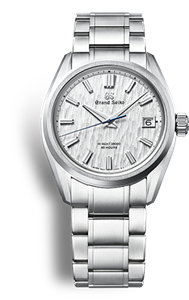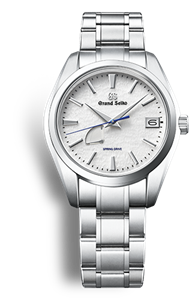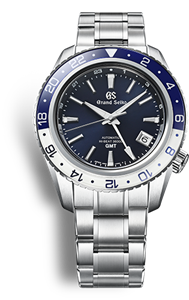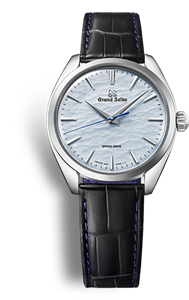Support
Each and every Grand Seiko watch is designed and manufactured with reliability and durability in mind. The same dedication to the long-term satisfaction of all Grand Seiko owners guides our policies in after-sales care, which we are committed to improving.
The after-sales service network of Grand Seiko is designed to be global, in which technicians with advanced expertise and high-technology equipment are dedicated to meeting the needs of our customers. The global Grand Seiko service network hold extensive inventories of all the components required to maintain all Grand Seiko watches for the longest possible period, and in many cases, even many years after a watch has ceased to be produced.
We do not set any definitive limit to the repair period for any Grand Seiko watch and we intend to give our utmost attention to each watch brought to our authorized service center. It is our aim to ensure that every Grand Seiko watch can be worn and enjoyed for a longest possible time, ideally a lifetime or longer. Of course, we cannot guarantee that every original component will be available for ever but our aim is to offer industry-leading levels of after-sales care and to ensure the complete satisfaction of our customers in the long term.
International Service Network
Select your Country/Region from the map
-
- Service Reception
- Contact List
-
Egypt
SEIKO Service Center, El Araby Building, 5th floor,
27 Abd El Aziz St, Downtown, CairoTel: 19319 (inside Egypt)
-
South Africa
Treger Brands (Pty) Ltd
26 6th Street, Wynberg, Sandton, 2090 (P.O. BOX 104, Wendywood, 2144), South AfricaTel: +27 11 089 6000
For watch repairs, please contact one of our Grand Seiko Boutiques or authorized retail partners. Find a Store
For any general inquiries, please find below the list of contact points for your country. -
- Service Reception
- Contact List
-
Japan
Seiko Watch Corporation
26-1, Ginza 1-Chome, Chuo-ku, Tokyo, 104-8118, JapanTel: 0120-612-911 (toll free dial in Japan)
Tel: +81-(0)3-3564-2111 (outside Japan)
-
Japan
[S.A.] Seiko Watch Customer Service
Shin-Nisseki Building 1F, 4-2, Marunouchi 3-chome, Chiyoda-ku, Tokyo 100-0005, Japan
*Please note the previous office was closed on February 21, 2025.
-
Brunei
Thong Sia Sdn Bhd (198201007297) (87055-A)
CP 27, Suite 2601-04, 26th Floor, Wisma Chuang, 34, Jalan Sultan Ismail, 50250, Kuala LumpurTel: +603 2141 5163
Fax: +603 2148 8766
-
Hong Kong & Macau
Thong Sia Watch Co Ltd (SEIKO Service Center)
21/F Stelux House, 698 Prince Edward Road East, San Po Kong, Kowloon, Hong KongTel: +852-2736-0235
Fax: +852-2730-5350
https://www.grand-seiko.com/hk-zh/
grandseiko@thongsia.com.hk
-
Indonesia
Seiko Service Center Jakarta Blok M
Jalan Melawai IX No. 46, Blok M, Jakarta Selatan, IndonesiaTel: +62 21 7208717
Fax: +62-21-7201249
-
Indonesia
Seiko Service Center Jakarta Senayan
Plaza Senayan Lt 3 No. 353-A, Jakarta Pusat, IndonesiaTel: +62 21 5725689
Fax: +62-21-7201249
-
Indonesia
Seiko Service Center Surabaya Tunjungan
Jalan Tunjungan No. 98-100, Surabaya, IndonesiaTel: +62 31 5474756
Tel: +62 31 5474757
Fax: +62 21 5725690
-
Indonesia
GRAND SEIKO Service Center Medan
Sun Plaza Level 1, C 32-33, Jln. KH. Zainul Arifin No.7 Medan, Sumatera Utara 20152Tel: 061-4501505
-
Malaysia
Thong Sia Sdn Bhd (198201007297) (87055-A)
CP 27, Suite 2601-04, 26th Floor, Wisma Chuang, 34, Jalan Sultan Ismail, 50250, Kuala LumpurTel: +603-2141-5163
Fax: +603-2148-8766
-
Nepal
Alfa Time Service Private Limited
SEIKO Showroom & Service Center In-front of Tindhara Pathshala, Durbar Marg, KathmanduTel: +977 1 4232 475
Fax: +977-1-4232-475
-
Philippines
Chronometer Corporation
18/F, Belvedere Tower, San Miguel Ave.Brgy, San Antonio Ortigas, Pasig City,1600, ManilaTel: +63-2-88655-0013
-
Singapore
Grand Seiko Boutique Singapore Marina Bay Sands
2 Bayfront Ave, B2M - 235, The Shoppes at Marina Bay Sands, Singapore 018972Tel: (+65) 6688 7202
https://www.grand-seiko.com/sg-en/
service@grand-seiko-apac.com
- Service Available
-
People's Republic Of China
Grand Seiko(Shanghai)Co.,Ltd
801B room, Skyline Tower, No. 99, West Tianmu Road, Jing'an District, Shanghai, 200070, P.R. of ChinaTel: 400-6905589 +86-21-62726219 (outside PRC)
Fax: +86-21-6272-0677
-
India
Alfa Time Service Private Limited
S-3 GCDA Complex, Gr Floor, Sea Side Marine Drive, Ernakulam, Kochi - 682 031, KeralaTel: +91-(0)484-2380708
-
Korea
Samjung Watch Co., Ltd
1st Floor, SJ Building, 21, Eonju-ro 126-gil, Gangnam-Gu, SeoulTel: +82-(0)2-511-3182
Fax: +82-(0)2-511-3185
-
Taiwan
Grand Seiko Boutique Taipei 101
1F, No.45, Shifu Rd., Xinyi Dist., Taipei City 110051, Taiwan (R.O.C.)Tel: +886-(0)2-8101-7914
Fax: +886-(0)2-8101-7993
-
Thailand
Grand Seiko Service Studio in Asia
SEIKO (Thailand) Co., Ltd. 2032 ITALTHAI TOWER FLOOR G, New Petchburi Rd., Bangkapi Huaykwang, Bangkok 10130Tel: +66-2-255-1245/50 (6 lines) #801 - 802
Fax: +66-2-654-9449
For watch repairs, please contact one of our Grand Seiko Boutiques or authorized retail partners. Find a Store
For any general inquiries, please find below the list of contact points for your country. -
- Service Reception
- Contact List
-
Brazil
ORIENT RELÓGIOS DA AMAZÔNIA LTDA.
Rua Libero Badaro, 425-17° Andar-conj. 172/174, São Paulo - SP, CP01009-905Tel: +55-11-3049-7777
-
Brazil
ORIENT RELÓGIOS DA AMAZÔNIA LTDA.
Av. Rio Branco, 89-11a andar-conj. 1.101, Rio de Janeiro - RJ, CEP 20040-004Tel: +55-21-2524-4522
-
Brazil
ORIENT RELÓGIOS DA AMAZÔNIA LTDA.
Praça XV de Novembro, 66 - 11º andar - conj. 1102 Porto Alegre - RS CEP 90020-080Tel: +55-51-3109-6252
-
Mexico
ARTIS Distribution SA de CV.
Puebla 302, Piso 11 "Col. Roma Norte, Del Cuauhtemoc C.P. 06700 Ciudad de Mexico"Tel: +52-55-9039-0137
-
Panama
WORLD TIME CENTRO DE SERVICIOS
Torre de las Américas, Lobby, Punta Pacifica, Panama, Rep. de PanamaTel: +507 366-5600
For watch repairs, please contact one of our Grand Seiko Boutiques or authorized retail partners. Find a Store
For any general inquiries, please find below the list of contact points for your country. -
- Service Reception
- Contact List
-
Andorra
Grand Seiko Europe S.A.S.
27/29 rue des Poissonniers, 92200 Neuilly-sur-Seine, FranceTel: +33 1 81 93 30 17
-
Austria
Grand Seiko Deutschland, Branch of Grand Seiko Europe S.A.S.
Parsevalstr. 9a/b, 40468 DüsseldorfTel: +49 (0)211/17142-432
-
Belgium
Grand Seiko Benelux, Branch of Grand Seiko Europe S.A.S.
Daniel Pichotstraat 17-31, 3115 JB Schiedam, The NetherlandsTel: +31 800 76873
-
Bulgaria
Grand Seiko Europe S.A.S.
27/29 rue des Poissonniers, 92200 Neuilly-sur-Seine, FranceTel: +49 (0)211/17142-432
-
Cyprus
Grand Seiko Europe S.A.S.
27/29 rue des Poissonniers, 92200 Neuilly-sur-Seine, FranceTel: +33 1 81 93 30 17
-
Czech
Grand Seiko Deutschland, Branch of Grand Seiko Europe S.A.S.
Parsevalstr. 9a/b, 40468 DüsseldorfTel: +49 (0)211/17142-432
-
Denmark
Grand Seiko Deutschland,Branch of Grand Seiko Europe S.A.S.
Parsevalstr. 9a/b, 40468 DüsseldorfTel: +49 (0)211/17142-432
-
Finland
Grand Seiko Europe S.A.S.
27 rue des poissonniers, 92200 Neuilly sur Seine, FranceTel: +33 1 81 93 30 17
-
France
Grand Seiko Europe S.A.S.
27 rue des poissonniers, 92200 Neuilly sur Seine, FranceTel: +33 1 81 93 30 17
-
Germany
Grand Seiko Deutschland, Branch of Grand Seiko Europe S.A.S.
Parsevalstr. 9a/b, 40468 DüsseldorfTel: +49 (0)211/17142-432
-
Gibraltar
Grand Seiko Europe S.A.S.
27/29 rue des Poissonniers, 92200 Neuilly-sur-Seine, FranceTel: +33 1 81 93 30 17
-
Greece
Grand Seiko Europe S.A.S.
27/29 rue des Poissonniers, 92200 Neuilly-sur-Seine, FranceTel: +33 1 81 93 30 17
-
Hungary
Grand Seiko Deutschland, Branch of Grand Seiko Europe S.A.S.
Parsevalstr. 9a/b, 40468 DüsseldorfTel: +49 (0)211/17142-432
-
Iceland
Grand Seiko Benelux, Branch of Grand Seiko Europe S.A.S.
Daniel Pichotstraat 17-31, 3115 JB Schiedam, The NetherlandsTel: +31 800 76873
-
Ireland
Seiko U.K. Limited.
First Floor, Building 1, Concorde Park, Maidenhead, Berkshire, SL6 4BY, United KingdomTel: +44 (0) 1628 770001
-
Italy
Grand Seiko Italy, Branch of Grand Seiko Europe S.A.S.
Via Giovanni da Udine 34, 20156 MilanoTel: +33 1 81 93 30 17
-
Luxembourg
Grand Seiko Benelux, Branch of Grand Seiko Europe S.A.S.
Daniel Pichotstraat 17-31, 3115 JB Schiedam, The NetherlandsTel: +31 800-76873
-
The Netherlands
Grand Seiko Benelux, Branch of Grand Seiko Europe S.A.S.
Daniel Pichotstraat 17-31, 3115 JB Schiedam, The NetherlandsTel: +31(0)10-4009899
-
Norway
Grand Seiko Benelux, Branch of Grand Seiko Europe S.A.S.
Daniel Pichotstraat 17-31, 3115 JB Schiedam, The NetherlandsTel: +31 800 76873
-
Poland
Grand Seiko Deutschland, Branch of Grand Seiko Europe S.A.S.
Parsevalstr. 9a/b, 40468 DüsseldorfTel: +49 (0)211/17142-432
-
Portugal
Grand Seiko Europe S.A.S.
27/29 rue des Poissonniers, 92200 Neuilly-sur-Seine, FranceTel: +33 1 81 93 30 17
-
Romania
Grand Seiko Europe S.A.S.
27/29 rue des Poissonniers, 92200 Neuilly-sur-Seine, FranceTel: +49 (0)211/17142-432
-
Serbia
Grand Seiko Europe S.A.S.
27/29 rue des Poissonniers, 92200 Neuilly-sur-Seine, FranceTel: +49 (0)211/17142-432
-
Slovenia
Grand Seiko Europe S.A.S.
27/29 rue des Poissonniers, 92200 Neuilly-sur-Seine, FranceTel: +49 (0)211/17142-432
-
Spain
Grand Seiko Europe S.A.S.
27/29 rue des Poissonniers, 92200 Neuilly-sur-Seine, FranceTel: +33 1 81 93 30 17
-
Sweden
Grand Seiko Benelux, Branch of Grand Seiko Europe S.A.S.
Daniel Pichotstraat 17-31, 3115 JB Schiedam, The NetherlandsTel: +31 800 76873
-
Switzerland
Grand Seiko Deutschland, Branch of Grand Seiko Europe S.A.S.
Parsevalstr. 9a/b, 40468 DüsseldorfTel: +49 (0)211/17142-432
-
Turkey
Aydin Saat Ithalat ve Ticaret A.S.
Metropol Istanbul, Ataturk Mahallesi, Ertugrul Gazi Sokak, C1 Blok Kat: 26 D:378, 34758 Atasehir/Istanbul, TurkeyTel: +90-216-225-30-40
Fax: +90-216-225-30-55
-
United Kingdom
Seiko U.K. Limited.
First Floor, Building 1, Concorde Park, Maidenhead, Berkshire SL6 4BYTel: +44 (0) 1628 770001
- Service Available
-
The Netherlands
Grand Seiko Service Studio in Europe
Grand Seiko Benelux, Branch of Grand Seiko Europe S.A.S.
Daniel Pichotstraat 17-31, 3115 JB Schiedam, The Netherlands
For watch repairs, please contact one of our Grand Seiko Boutiques or authorized retail partners.Find a StoreTel: +31(0)10-4009899
-
Russia
Swissmaster
Leninsky ave., 30, Moscow, 119334Tel: +7(495)927-05-46
-
United Kingdom
Seiko U.K. Limited.
First Floor, Building 1, Concorde Park, Maidenhead, Berkshire SL6 4BY
Please note: Service & Repairs via post/courier only. For security reasons, we ask you kindly not to visit our offices in person.Tel: +44 (0) 1628 770001
For watch repairs, please contact one of our Grand Seiko Boutiques or authorized retail partners. Find a Store
For any general inquiries, please find below the list of contact points for your country. -
- Service Reception
- Contact List
-
Bahrain
Bahrain Jewellery Center
MODA MALL, SHOP # 74, NEAR GATE 6, GOVERNMENT AVENUE, MANAMA, KINGDOM OF BAHRAINTel: +973 - 1752 0082
Fax: +973 - 1752 0059
-
Israel
OMTIME LTD.
48, Ha Azmaut Str. Yahud, 5630421 P.O.B. 1158, IsraelTel: +972-(0)3-5172540
Fax: +972-(0)3-5102964
-
Jordan
NASOUH KAYALI SONS COTIME CENTER Service Center
Um Uthainah Shatt Al Arab P.O.Box 630 Amman 11118, JordanTel: 00962 6 556 1530
-
Kuwait
Morad Yousuf Behbehani
Shuwaikh industrial- block 1- street 11Tel: +96524967761/60
-
Lebanon
Cadrans
Dbayeh Highway, LebanonTel: (Tel) +961 4 402 156
Tel: (Mob) +961 3 102 769
-
Oman
LE CARAT
OPERA GALLERIA, ROYAL OPERA HOUSE MUSCAT. OMANTel: +968 2200 9992
-
Qatar
Mannai Trading Co. WLL.
Post Box 76 Building # 233,street # 230, Zone # 41 “C” Ring road Doha, QatarTel: +974-4455-8795
Fax: +974-4455-8781
-
Qatar
AL MAJED JEWELERY
- Bldg 23, Zone 38, Street 901 Suhaim Bin Hamad Street, Al Sadd, Doha, QatarTel: 00974 4447 8888
Fax: +974-4447 7700
-
Saudi Arabia
Al-Hussaini & Al Yahya Investment Group (Service Centers)
Hala Commercial Tower; 3rd Floor - Block 'B' - Middle Block King Khalid Street Al Baghdadiyah Al Gharbiyah - JEDDAH PO Box 1991, Jeddah-21441Tel: +966-12-648-666 Ext.106
-
U.A.E.
Al-Futtaim Watches & Jewellery Co. L.L.C.
Dar Al Muteena Building Mezzanine Floor, Near Fish Round About, P.O. Box 7916, Deira, Dubai, United Arab EmiratesTel: +971-4-7016900
-
U.A.E.
Al-Futtaim Watches (Dubai Service Center)
Dar Al Muteena Building, Ground Floor, Near Fish Round About, P.O. Box 7916, Deira, Dubai, United Arab EmiratesTel: +971-4-2227707
For watch repairs, please contact one of our Grand Seiko Boutiques or authorized retail partners. Find a Store
For any general inquiries, please find below the list of contact points for your country. -
- Service Reception
- Contact List
-
Canada
SEIKO Hong Kong Limited Canada Branch
60 Prince Andrew Place, Toronto, Ontario, Canada M3C 2H4Tel: +1-647-288-2222
Fax: +1-647-288-2323
- Service Available
-
U.S.A
Grand Seiko Service Studio in Americas
Grand Seiko Corporation of America - Service Center
2 Park Way Suite 2A Upper Saddle River, NJ 07458, U.S.ATel: +1-800-334-0962
https://www.grand-seiko.com/us-en/
https://grandseikoserviceusa.com/
custserv@grand-seiko.us.com
For watch repairs, please contact one of our Grand Seiko Boutiques or authorized retail partners. Find a Store
For any general inquiries, please find below the list of contact points for your country. -
- Service Reception
- Contact List
-
Australia
Seiko Australia Pty. Ltd.
PO BOX 314 North Ryde NSW 1670Tel: +61-2-9805-4666
Fax: +61-2-9887-3736
-
New Zealand
Seiko Australia Pty. Ltd. (NZ Branch)
226A Bush Road, ALBANY, North Shore City 0632 (PO Box 100037 North Shore City 0745, Auckland)Tel: +64 9 415 5668
For watch repairs, please contact one of our Grand Seiko Boutiques or authorized retail partners. Find a Store
For any general inquiries, please find below the list of contact points for your country.
FAQs
The Grand Seiko Standard is a Seiko-exclusive accuracy standard for mechanical watches which has been established to ensure superior performance of Grand Seiko mechanical watches irrespective of the differences in environmental conditions in which a watch is used. "Grand Seiko Standard Inspection," which measures gain / loss (daily rate) under various environments, is carried out at the manufacturing plant for 17 days in total, and only mechanical watches that satisfy the standard are given the title of "Grand Seiko."
The Grand Seiko Standard differs from the other recognised chronometer standards in two important respects. While most accuracy standard testing is done for five positions at two temperatures, the Grand Seiko Standard tests six positions at three temperatures. This is because the Grand Seiko Standard seeks to replicate real world conditions. The sixth position, namely the 12 o’clock upright position, is the way many people place their watch when not wearing it. In addition, the extra temperature rating is closer to body temperature. The idea is simple - to test the watch under conditions similar to actual use.
The Grand Seiko Standard Inspection Certificate certifies that the measured values of a movement, which were measured in a scientifically controlled environment in the manufacturing plant, have passed the Grand Seiko Standard Inspection. The certificate is printed with the caliber number, movement serial number, and case serial number.
- Inspection of the movement for the Grand Seiko Standard Inspection Certificate is made prior to casing. Movement performance is carefully measured in the static position under scientifically controlled conditions.
- The accuracy of the watch may vary depending on the actual usage conditions and may differ from the certified accuracy.
The Grand Seiko Standard Inspection Certificate cannot be reissued.
The accuracy of Grand Seiko differs according to the mechanism and caliber of your watch. For details on your watch, please refer to the instruction that came with your watch at the time of purchase.
Guidelines for the accuracy of Grand Seiko while in use:
QUARTZ : The annual accuracy is ±10 seconds when worn on the wrist within a normal temperature range (between 5 ºC and 35 ºC) for approximately 8 hours per day.
SPRING DRIVE : Average monthly loss / gain is ±15 seconds when worn on the wrist within a normal temperature range (between 5 ºC and 35 ºC).
MECHANICAL : Accuracy of Grand Seiko mechanical watches when worn is specified within the target range of -1 to +10 seconds per day. To properly judge the accuracy under normal use conditions, check the mean value of gain / loss over a period of seven to ten days.
The accuracy of mechanical watches varies slightly from day to day, depending on various conditions. Therefore, the loss / gain of mechanical watches is not measured by a daily rate, but by an average daily rate over a period of 7 to 10 days. For this reason, the accuracy of mechanical watches is indicated by "the mean daily rate."
The accuracy of the mechanical watch in use
The accuracy of a mechanical watch varies slightly depending on individual user conditions such as winding state of the mainspring due to movement of the users’ arm, ambient temperature, and posture (direction of the watch). Accordingly, actual accuracy of a watch in use may differ from specifications in the "Grand Seiko Standard."
The target accuracy range of Grand Seiko mechanical watches in use is -1 to +10 seconds per day. To determine accuracy in use, measure loss / gain under normal use conditions for
approximately 7 to 10 days and calculate the average loss / gain per day.
The accuracy of the mechanical watch movement at rest
To establish a benchmark accuracy of a mechanical watch which does not depend on usage environment, loss / gain of a mechanical watch is measured before the movement is assembled in the case. The accuracy of the movement is measured under controlled conditions over a certain number of days, and the result is called "the accuracy of a mechanical watch movement at rest."
The measurement result for each watch is written in the "Grand Seiko Standard Inspection Certificate," which is provided with the watch by the retailer at time of purchase. This result is an average loss / gain of time over a 17 day period, which was measured in the factory where the temperature and position of the movement are controlled in accordance with the "Grand Seiko Standard."
The accuracy written on the Grand Seiko Standard Inspection Certificate is the accuracy of the Grand Seiko mechanical watch movement at rest, which is measured before the inside movement of the watch is assembled in the case. Since the accuracy of a mechanical watch varies slightly depending on individual user conditions, the actual accuracy during use may differ from the numerical value specified in the certificate. The accuracy is affected by conditions such as winding state of the mainspring due to movement of the users’ arm, ambient temperature, and posture (direction of the watch).
The target accuracy range of Grand Seiko mechanical watches in use is -1 to +10 seconds per day. To determine accuracy in use, measure loss / gain under normal use conditions for approximately 7 to 10 days and calculate the average loss / gain per day.
To ensure that your watch remains in perfect working order, please take the following simple procedures:
- Avoid putting the watch too close to strong magnetic fields such as those generated by large TV sets or other large electronic devices.
- When you take the watch off, wipe away any moisture with a soft cloth. This will help enhance the life of the case and gaskets.
- If the watch is exposed to salt water, wash it in fresh water.
- Do not leave your watch in a place where the temperature drops below 5°C or rises above 35°C for prolonged periods.
- If your watch has a mechanical movement, try not to leave the watch unworn for too long. Your Grand Seiko watch performs best when worn for at least 10 hours a day.
- We recommend that you have your watch checked and overhauled periodically. Optimally, this should be done every three to four years.
As time goes by, it is possible that you may scratch your watch slightly. We hope this never happens, but if it does, we have a special polishing service available.
You might like to have your watch polished when it is with us for a normal service. Please consult your Grand Seiko retailer for details.
This Grand Seiko polishing service is performed by our very best craftsmen and women. Please take note of the following points:
- Polishing of certain parts may not be possible due to their special construction or material.
- If the damage is severe, it may not be possible to remove it by polishing alone.
- The finish may be very slightly different from the original, as the polishing is done by hand.
- The crown, pushers, case back and the emblem on the band cannot be polished.









